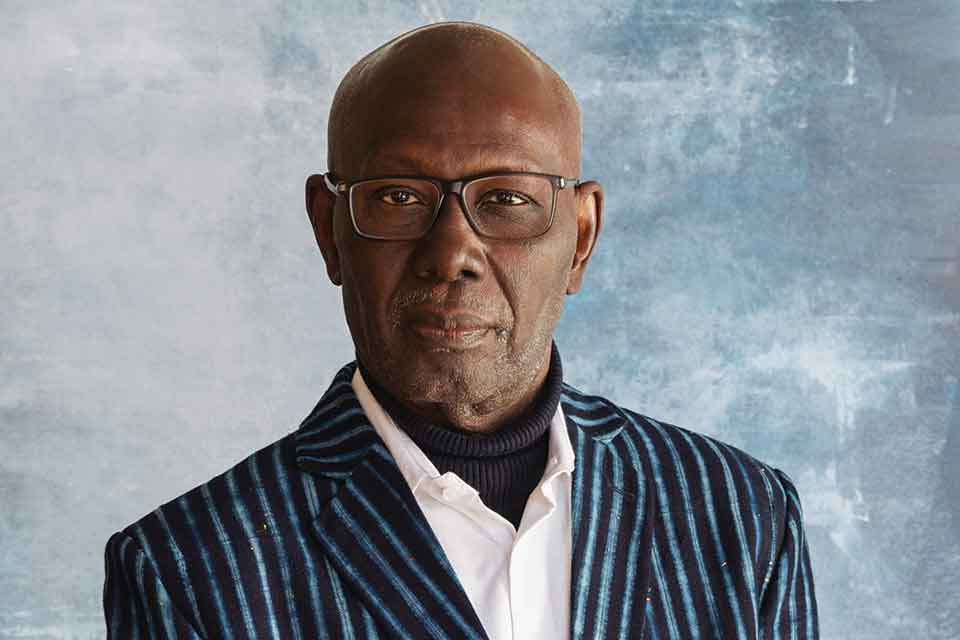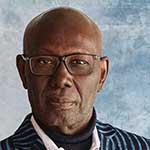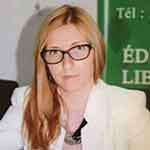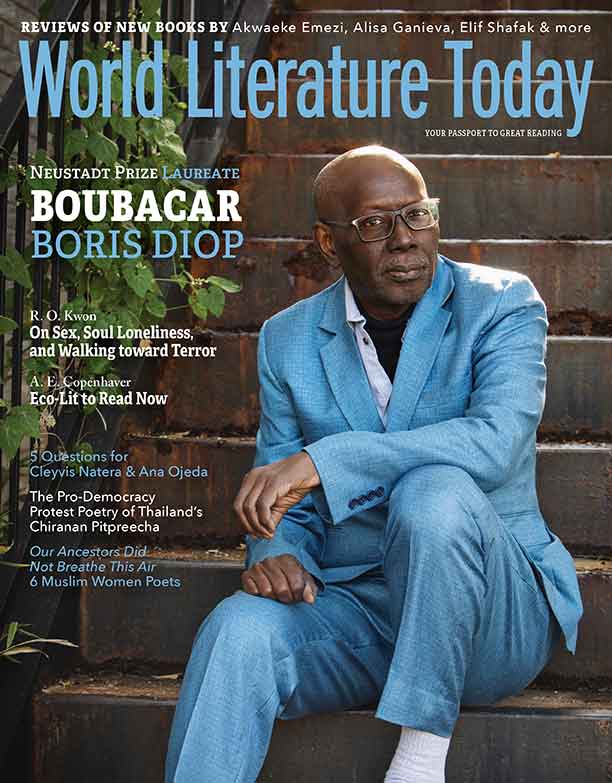How Do We Say “Genocide” in Wolof? The 2022 Neustadt Prize Lecture

Diop delivered the following keynote talk to a packed audience at the University of Oklahoma during the 2022 Neustadt Lit Fest (October 24–26, 2022), which was also livestreamed to participants from more than forty countries, from Albania to Uzbekistan.
In this particular story, the orphan, who was coming of age, was named Youmané. I loved her name so much that I am not quite sure if I hadn’t invented it myself. In fact, I was never passively listening to my mother-storyteller; my lively reactions were an integral part of the unfolding of her story. So, I am going to tell you the story of a young girl named Youmané.
Her mother had forbidden her from going to the nocturnal tam-tam sessions. But the tam-tam’s calling made her lose her mind. Every night, she would secretly go there, “when the sand under her feet had turned cold,” as my mother-storyteller would beautifully utter. Yet Youmané wasn’t aware that she was the only human being in an assembly of supernatural creatures, the Jinne. There she fell in love with a young man, devilishly handsome of course. And what everybody dreaded the most ended up happening: she became pregnant. At this point, the storyteller had a serious problem: How to talk about the torrid sexual relationship between two lovers to children who were only eight or nine years old? I can still remember with an amused smile the narrative creativity of the storyteller; “every night,” she would say, “a strong wind lifted Youmané’s dress on her way back home.” That was it. But after the wind swirled around her several times, which in fact were breezes of another kind, Youmané was pregnant!
What happened next? Whether Youmané was punished by her mother or whether her child became a great king, I had no idea at all. And to tell you the truth, it was because I wasn’t really interested in finding out. I can only remember the dread with which my heart was beating when I imagined Youmané in the midst of the Jinne, with distorted or, worse, triangular faces, ready to drink her blood at any moment. The fact is that out of the hundreds of stories I had heard in my early childhood, only vague impressions have remained, images of dark-blue or gray colors, as in a painting, and in the abyss of twisted forms, vulnerable beings face-to-face with elements running wild. In fact, those frightened beings were often young women, like in the tale “Niantanta,” which impressed me so much that I believe I have included it in every one of my novels in one form or another. What I quickly learned with these stories is the extent to which what happens in a story—its content, in sum—remains almost always accessory. One can very well stop reading a novel before even reaching its final page, after a good portion of the narrative dazzles. That’s why every time someone asks me to sum up Anna Karenina—or other great fiction—I do my best but can’t stop thinking that they don’t know what writing is actually about.
Indeed—shouldn’t we consider this to be universally true?—tales should only be narrated at night.
Indeed—shouldn’t we consider this to be universally true?—tales should only be narrated at night. It made more truthful and worrisome the supernatural realm that I became familiar with, even before my reading of Ahmadou Kourouma or Amos Tutuola, and later Latin American authors from Juan Rulfo to Julio Cortázar, Gabriel García Márquez or the Argentine Ernesto Sábato, one of my favorite novelists. In other words, I wasn’t really impressed by “magical realism” since, in Macondo, I was on familiar ground.
I know it may sound paradoxical, but those oral tales have been my best writing workshop, even before French school initiated me to the mystery of the alphabet. The aura of those beautiful stories was primarily the result of a sort of impenetrability. The whole of their meaning resided in a sort of orgy of sound and a power of suggestion that gave them a rare intensity. I strongly believe, had I not got lost in the imaginary maze of my mother-storyteller, that I wouldn’t later have experienced such a great pleasure in reading, again and again, fully esoteric tales. I never felt dismayed for not being able to access “the message”—the most terrible word of all—of an author. The truth is, most texts have been and still are a delight to me by their sole vibration and because they scattered, so to speak, in all directions. It is not surprising that I chose to make Khadidja, the heroine of my third novel, The Knight and His Shadow, a peerless storyteller.
* * *
A few years before hearing those tales in the town of Thiès, Médina—the district in Dakar where I was born—had been my school of life, or rather my street school, as we lived in it by lack of choice. It is only now in retrospect that I realize what a filthy, poor slum it was, as we see today in certain outer zones of Dakar. As a teenager, I didn’t see the misery of Médina but instead the glorious modernity of a place that was, at that time, the source of all new trends. In Médina, called Niarela in my novel Doomi Golo, the most brilliant minds would meet: doctors and lawyers, artists and athletes, particularly those who are still remembered as Senegalese soccer and basketball legends.
As a teenager, I didn’t see the misery of Médina but instead the glorious modernity of a place that was, at that time, the source of all new trends.
Médina was adjacent to the European district of Plateau, against which it constantly measured itself, although this was during the colonial era. In between they built in Rebeuss the biggest prison of the country—which is still there—and which was frequently visited by some of our elders adept at defying the law, especially the laws of the toubab, the white man. One of them was Yadikone, a kind of Robin Hood, immortalized by the great filmmaker Djibril Diop Mambéty. Médina was also, naturally, the stage of epic political confrontations between the “red party” of Lamine Guèye’s Senegalese Socialist Party (sfio/pss) and the “green party” of the poet Léopold Sédar Senghor, who was more progressive—or maybe less reactionary—than his “socialist” rival (who, anecdotally, was my maternal great-uncle). Senghor ultimately became the father of independent Senegal and its first president. The country could have found someone better, but that is another story . . .
Médina is also where a few friends and I created the “Culture and Leisure Club.” Its main members were the Bèye twins, Assane and Ousseynou, Ben Diogaye Bèye, who became a renowned filmmaker, the late Assane Preira, and finally Babacar MBow, the Master of Ndem (aka “Chacun”), who today is a respected figure of Muridiyya spirituality. Near the area of the Corniche we had a “ciné-club” where we discussed for hours and hours the very first African films, all short features, as well as Momar Thiam’s Sarzan and Black Girl, by Ousmane Sembène, the father of African cinema, whose Borom Sarret was frequently at the center of our debates. There was also Afrique-sur-Seine, by Paulin Soumanou Vieyra, and one of our favorites, Et la neige n’était plus, by Ababacar Samb-Makharam. However, our most common activities revolved around books. While I discovered there Malick Fall’s La plaie, Sembène’s God’s Bits of Wood, Cheikh Hamidou Kane’s Ambiguous Adventure, and Aké Loba’s Kocoumbo, l’étudiant noir, our choice of reading went far beyond Africa’s borders.
In our sometimes-stormy reading sessions we read Camus’s L’étranger or another French classic. And Gregor Samsa’s name, the main character of Kafka’s The Metamorphosis, would often come up in our jokes. I remember also that one of us, Ousseynou Bèye—to this day one of my best friends—loved to repeat, “Thank God, at least we can act,” like Chen in Man’s Fate, by André Malraux. We would also organize discussions about economics and politics. I found out later that our early taste for politics had attracted the attention of an underground Communist movement that would regularly send us their recruiters. To top it all off, we created a journal—mimeographed, of course—titled Le bourgeon. I had myself found the title in an article by the poet David Mandessi Diop, who died in a plane crash off the coast of Dakar at the age of thirty-three, in which he wrote the following: “Literature is the expression of reality in movement. It begins where reality starts, captures it, seizes it while it is just a bud [bourgeon], and helps it bloom.” Thinking back, I am stunned that we were able to do so much at such a young age. . . .
Even so, it is not surprising that I wrote my first novel, entitled La cloison, when I was about sixteen. It was handwritten, of course, with the seriousness of a shy teenager who had a severe stutter. The novel was about the friendship between Kader Cissé, a Senegalese adolescent, and his French classmate Lucien Gercet. They were both of modest circumstances and met at Van Vollenhoven, a high school with mostly white students and teachers. I was attending it too and felt discriminated against by the teachers, especially by Monsieur Nègre, which was indeed an unexpected name for a racist. La cloison therefore “courageously” denounced racism, and, in a candid, happy ending, the partition, symbolic of the division between the two races, spectacularly caught fire, allowing Kader and Lucien to be reconciled forever.
I didn’t write a novel of more than two hundred pages just like that for no reason and without knowing what I wanted to do with it. I would pretend that I was published like all the great authors I had such pleasure reading and rereading. The manuscript was sent from Dakar to the Parisian publisher Présence Africaine, which was everyone’s lodestar at the time. In response, I received a standard rejection letter signed by a certain Jacques Howlett. That name is the only thing I remember from this failed initial publishing experience.
Very quickly afterward came the time when, in the Faculté des Lettres of Cheikh Anta Diop University (ucad), we had to read the Marxist classics and make a clear choice between Mao, Tito, Stalin, Trotsky, or Enver Hoxha. It luckily didn’t prevent us from also reading Cheikh Anta Diop, Frantz Fanon, Mongo Beti, Amílcar Cabral, and Aimé Césaire. In fact, all those authors well complemented one another. Much could be said about that period, including with regard to the “Club Frantz Fanon,” founded in a neighborhood in Dakar to which my mother had moved.
I soon became an even more avid and solitary reader. The American Cultural Center gave me the opportunity to read all of Steinbeck but also some less well-known novelists like Erskine Caldwell. I read Faulkner’s Light in August and Richard Wright’s Native Son. At the French Cultural Center, I discovered and read all the books by Jean-Paul Sartre, except his monumental and cryptic philosophical treatises. I ended up declaring myself an existentialist when everybody around me was wild about Marxism. I admired so much Boris Serguine, a character from Sartre’s trilogy The Roads to Freedom, that it gave me my pen name. Like everybody else I was very fond of Latin American literature to the point of writing in my first novel, Le temps de Tamango, that “One Hundred Years of Solitude is the absolute masterpiece of universal literature.” This was a naïve enthusiasm of my youth, but it also showed the emotional shock triggered by García Márquez’s novel. My opinion about his book would be much more measured today!
I ended up declaring myself an existentialist when everybody around me was wild about Marxism.
These eclectic reading experiences and all the activities I was engaged in, often at a very early age, coincided well with the typical journey of a francophone writer.
* * *
There was, however, a sudden halt for me after 1998. It was the year I went to Rwanda for the first time with a group of writers from different African countries to assess the extent of damage caused by the 1994 genocide against the Tutsi. The organizers of the project asked us to provide a fictional testimony of our experience, but only if we wanted to. This exceptional initiative, involving ten African authors going to investigate at ground zero of an enormous contemporary tragedy, was called “Rwanda: Writing as a Duty of Memory.” This experience gradually led me to put the genocide against the Tutsi at the center of my reflection and to give a greater importance to my mother tongue in my creative writing. In sum, it ultimately led me to convey in Wolof a genocide that had completely turned my mental sphere upside down.
The Knight and His Shadow is the first book I wrote that mentions the genocide in Rwanda. It had devastated the country four years earlier, and having never been interested in it, I saw in the genocide, with the typical contempt of the writers of my generation, yet another African disaster. I was so ignorant about the real facts that had occurred between April and July 1994 in Rwanda that my narrative lightheartedly blurred the line between the perpetrators and their victims. The leaders of refugee camps in the former Zaire, whom I depicted as heroes, were in fact the masterminds of the genocide who had fled Rwanda after having committed the worst atrocities. The episode indeed only takes up a small amount of space in The Knight and His Shadow, but it was nonetheless embarrassing, given the historical importance of the event.
The genocide in 1994, when at least ten thousand people were killed every day for one hundred days and without a single day of reprieve, involved Tutsis being butchered with machetes, burned alive, thrown alive in cesspools, or deliberately infected with HIV. A gigantic disaster had befallen a small African country, and, four years later, I was still reading it upside down. By digging a little bit, I realized that if African tragedies repeat themselves with such a sinister regularity, it is because either we don’t know how to prevent them or simply accept not to see them at the very moment they are destroying entire countries.
How not to question oneself after such a realization? I didn’t want to let myself be trapped by the old stereotypes, which perceive Africa as a bloodthirsty place where tribes massacre one another, almost for no reason, since time immemorial. That is why Murambi: The Book of Bones is by far my most documentary novel. To write it, I read many books and articles and watched every movie on this topic I could find. I talked to survivors and to killers in prison. A harvest of facts, which I insisted on using with great caution, had emerged. For example, I made sure that the realistic description of certain barbaric acts did not incite the reader to see the entire novel as pure invention and thus remain in their comfort zone. In fact, the old question whether we can write fiction or not about genocide was tormenting me: Who would indeed believe that something like this actually happened?
That’s exactly why any novel about genocide never stops denying being a novel. I wrote Murambi: The Book of Bones while making sure that I always remained one tone below, and it is therefore not a coincidence that it’s the most accessible of my books, from Les tambours de la mémoire to Les traces de la meute. Writing amidst the stench of so many dead bodies quickly eliminates the urge for complicated literariness. Those “signatures” of avant-garde aesthetics, which I was so keen on before Rwanda, suddenly seemed frivolous in the face of such human suffering. It’s because of similar writing pirouettes that I ended up praising the assassins who fled to the DRC. I decided that it would never happen to me again. This experience can make anyone lose their innocence since, beyond literature—I know that I don’t write the same way since Murambi was published—I wanted to understand what had really happened in Rwanda.
In particular, I discovered that it was to promote its language that the French state under François Mitterrand, actively and with boundless determination, got involved in the genocide alongside mass murderers of the elderly and newborn babies. Having been denied with indignation for a long time by Parisian intellectuals, this complicity is now widely documented and recognized by everybody, including by the French public.
As for me, until my stay in Rwanda, I had criticized imperialism and neocolonialism in the vein of classical Marxist theorists, and thinkers such as Frantz Fanon, Kwame Nkrumah, and Cheikh Anta Diop had taught me how to despise these notions. It all remained quite abstract in my mind, however. The dead of Rwanda brought to this reflection the weight of their blood. In fact, it pushed me to analyze the domination that former French colonies are still the victims of sixty years after independence, which is well conveyed in the neologism Françafrique coined by François-Xavier Verschave. Beyond the book Négrophobie, which I co-authored in 2005 with Verschave and Odile Tobner, I have never stopped denouncing this system of mafia-type economics and the archaic pillage of Africa.
All that allowed me to better understand why France was investing so much money and energy on the African continent for the defense of its language. And yet I had chosen to write fiction in French. I therefore realized my involvement in an extraverted African literature, written in colonial languages and “historically condemned,” to borrow a phrase from David Mandessi Diop. Apart from Ngũgĩ wa Thiong’o and Cheikh Anta Diop, “The Novel in Africa,” by J. M. Coetzee, had triggered my interest in the subject. In it, Elisabeth Costello says to the Nigerian novelist Emmanuel Egudu:
The English novel . . . is written in the first place by English people for English people. The Russian novel is written by Russians for Russians. But the African novel is not written by Africans for Africans. African novelists may write about Africa, about African experience, but they are glancing over their shoulder all the time as they write at the foreigners who will read them. Whether they like it or not, they have assumed the role of interpreter, interpreting Africa to the world. Yet how can you explore a world in all its depth if at the same time you are having to explain it to outsiders?
* * *
My desire to write in Wolof has always been there. Although it was somewhat scattered and uncontrolled, it was part of my cycle of reflection, triggered by a wish to better understand the genocide against the Tutsi, which ultimately pushed me to take action.
Here I want to bring back my mother-storyteller. She had never set foot in a French public school, so it was in Wolof that she described the love story of Youmané and “the storm.” Without even knowing it, she was preparing me for literary creation in my mother tongue. It would take too much time to explain how I switched from one language to another, but I can simply say that I owe an immense joy to my three novels Doomi Golo, Bàmmeelu Kocc Barma, and Malaanum Lëndëm, as well as the translation of Césaire’s A Season in the Congo, which I had never experienced when I was writing in French. This process of self-reconnection, eminently political, is not limited to creative writing. My friends and I have created a publishing house in African languages. And it is not by coincidence that we chose to call it “EJO,” which is a word in Kinyarwanda. We also teach Wolof and have created Lu defu waxu, which to this day is the only online Senegalese newspaper in Wolof.
Without even knowing it, my mother-storyteller was preparing me for literary creation in my mother tongue.
Being born in Dakar and coming back several years later from Thiès, my mother-storyteller’s town—as much as my father’s library, which I have often talked about—has had an enormous impact on my intellectual growth. I was able, without much effort, to get rid of my destiny as a francograph writer and to start expressing in my mother tongue the dreams and suffering of the Rwandan people, of the Senegalese people, but also of all humanity.
Norman, Oklahoma
October 25, 2022
Translation from the French












